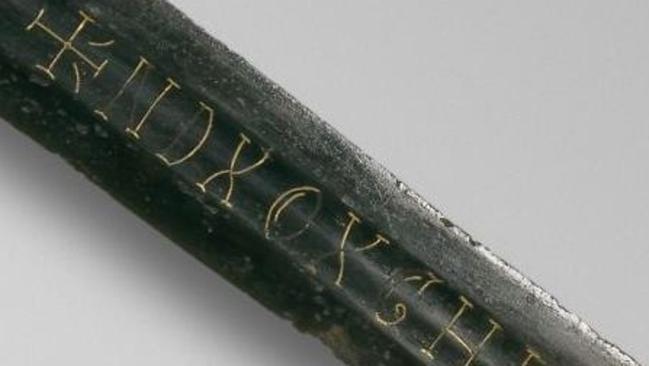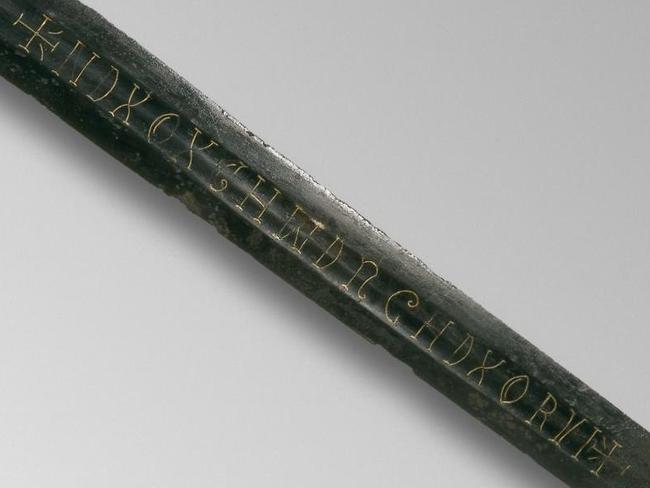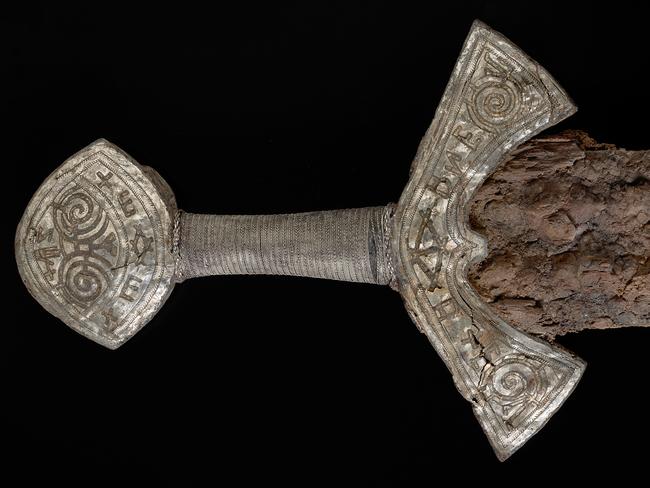Help solve a medieval mystery: Decode the inscription on this 13th Century sword
IT’s a medieval mystery that has researchers stumped: What’s the meaning of the cryptic code on the blade of this 13th Century sword?

IT’s a medieval mystery that has researchers stumped: What’s the meaning of the inscription on the blade of this 13th Century sword? The British Library is turning to the public for help.
It’s a deadly weapon and an assertive symbol of authority.
The medieval sword was far more than just man-bling: It was welded to their personality and social status.
It could also cleave a man’s skull with a single blow.
So there’s little surprise many believed they could be imbued with magical powers.
Others simply took the time, effort — and expense — to have them personalised with the iconography of their houses and significant sayings.
So what’s with the 13th Century sword that has the British Library appealing for help?
And then there’s the 2000-year-old Viking sword recently found in Norway: Does its secret inscriptions expose an Early Christian among the pagan warriors?
Cryptic message
Nobody can decrypt the medieval inscription so carefully etched into its blade.
“An intriguing feature of this sword is an as yet indecipherable inscription, found along one of its edges and inlaid in gold wire,” a British Library statement reads. “It has been speculated that this is a religious invocation.”
+NDXOXCHWDRGHDXORVI+

What’s the language?
What’s the message?
Then there’s the annoying habit in many medieval inscriptions to turn significant phrases into acronyms. The assumption was it was so well known it wouldn’t need to be spelt out in full.
RELATED: Tracing the ‘magic’ of Europe’s super swords
An update of the British Library website contains this suggestion, prompted by their appeal: “NDXOX, possibly standing for Nostrum Dominus (our Lord) or Nomine Domini (name of the Lord) followed by XOX ... Perhaps these letter combinations — XOX ... – refer to the Holy Trinity.”
Another suggestion is that it may be medieval Welsh, reading: “No covering shall be over me”.
Others are slightly more tongue-in-cheek: “This was clearly St George’s sword: Now, Dagger: O ClasH With DRaGon’s HeaD! O Reap VIctory!”
But the sword’s backstory has been totally lost, removing the vital context necessary for a reliable translation.
Secrets in the steel
The double-edged sword itself was pulled from the River Witham, near Lincoln, England, in 1825.
It’s outstanding quality was immediately apparent, the fine-steel blade having withstood centuries of exposure to the elements particularly well.
It’s a weapon similar to others from the 13th Century, but it does have several strange features.
“The blade is unusual as it has two fullers, or grooves, running parallel down its length on each side,” reports The British Museum. “A Viking origin has been suggested for the sword on the basis of the fullers, the pommel and the letter forms of the inscription. However, it is apparent that the pommel, inscription and the blade shape are more characteristic of Medieval European swords.”
The sword is on display as part of the Magna Carta exhibition, celebrating the 800-year-old influence of the groundbreaking legal document.

A Viking’s Christian spell?
Another sword with a mysterious inscription has recently been put on display in Oslo. The Viking blade, believed to be almost 2000 years old, was found in Langeid, Setesdal, southern Norway, in 2011.
It’s a unique find.
Embellished with gold, ornamentation — and inscriptions — nothing like it has previously been seen.
While the 94cm blade has rusted, the handle is well preserved. It is tightly wrapped with silver thread, with details in gold and copper-alloy.
Among the decorative spirals are combinations of letters and cross-like impressions. While likely Latin, their meaning is as yet unknown.
““At the top of the pommel, we can also clearly see a picture of a hand holding a cross,” excavator Camilla Cecilie Wenn of the Museum of Cultural History said. “That’s unique and we don’t know of any similar findings on other swords from the Viking Age. Both the hand and the letters indicate that the sword was deliberately decorated with Christian symbolism. But how did such a sword end up in a pagan burial ground in Norway?”




